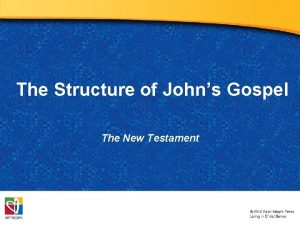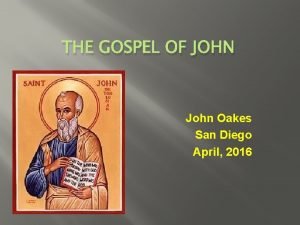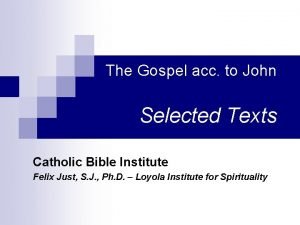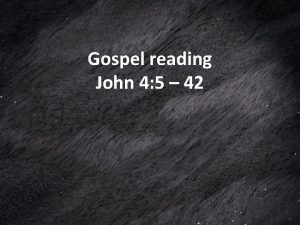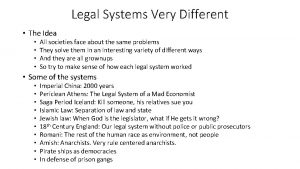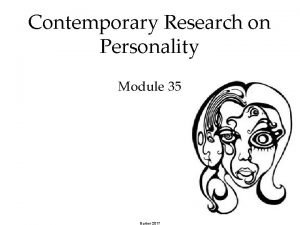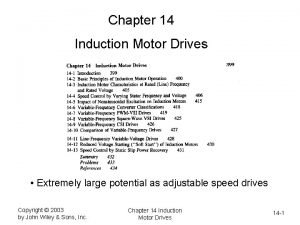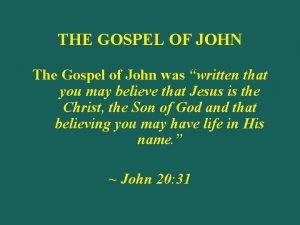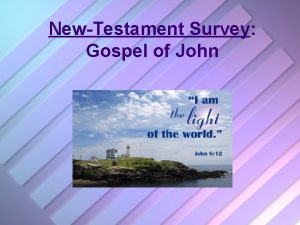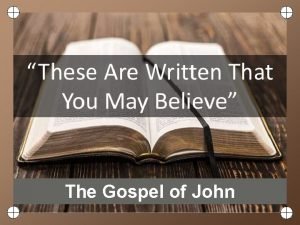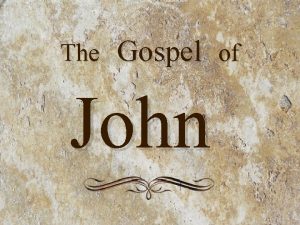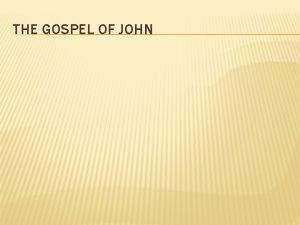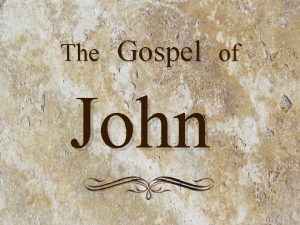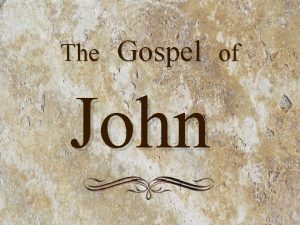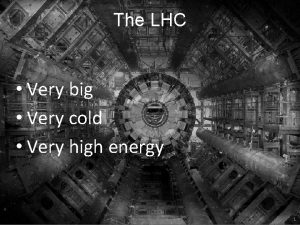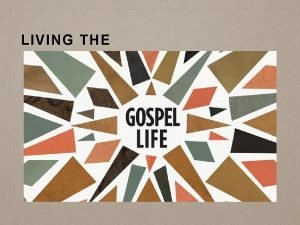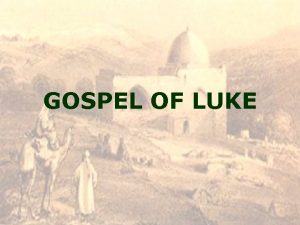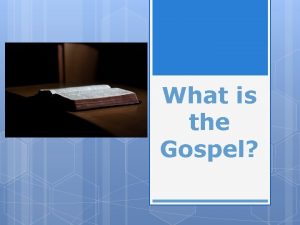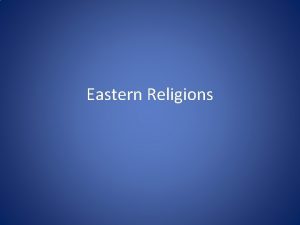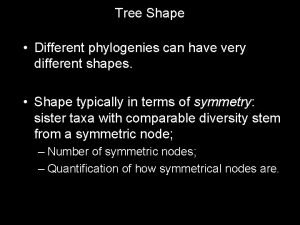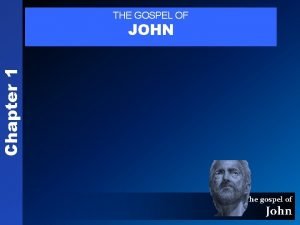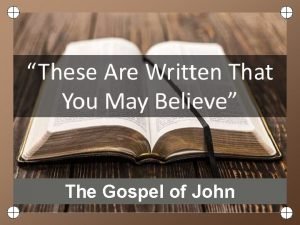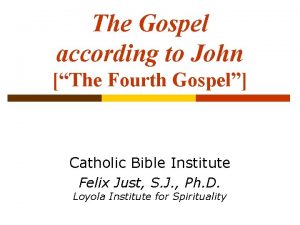GOSPEL OF JOHN THE UNIQUE GOSPEL Very different


























- Slides: 26

GOSPEL OF JOHN – THE UNIQUE GOSPEL

Very different from Synoptic gospels – stands out on its own Says less about life of Jesus & more about “Johannine” community of Christians circa 100 CE – their theology & understandings of Jesus (see Box 12. 12, pg. 409) Very high view of Jesus’ divinity Heavy use of symbols & symbolic language

Purpose of gospel is to inspire readers to faith in Jesus’ divinity Miracles are referred to as “signs” & these signs are meant to enable reader to see that Jesus is the “word made flesh. ” Probably not written by John the apostle – written as a pseudonym sometime between 90 -100 CE (last of the four gospels to be written).

WHAT MAKES IT UNIQUE? • Writer of John did not use Synoptics as resource • No birth story – instead, Jesus is eternal logos (Greek for “word”) • No temptation in the desert • Delivers long philosophical speeches, usually about his nature (something the Johannine community would have been fond of doing)

WHAT MAKES IT UNIQUE? • No recitation of Mosaic Law & Hebrew ethical directives – only commandment is “to love. ” • No prediction of downfall of Jerusalem • Minimized expectation for Jesus’ second coming • No agony before arrest in Gethsemane

WHAT MAKES IT UNIQUE? • The “I AM” sayings – Jesus referring to himself – Echo God’s revelation to Moses (Exodus 3: 14) – “I AM WHO I AM” – highlights Jesus’ divinity – Some of them: • • "the bread of life"(6: 35) "the light of the world"(8: 12) ”the door of the sheep"(10: 7) "the good shepherd"(10: 11) "the true vine"(15: 1) "the way, truth, life"(14: 6) "the resurrection and the life"(11: 25)

THE WORK OF THE PARACLETE • Jesus not just historical figure, but an immortal being who still inhabits Johannine community. • Accomplishes this via PARACLETE (14: 26 ff) – Greek word, means “Advocate” or “Helper” – Translated as “Holy Spirit” or “Holy Ghost” • Paraclete’s function is to define Jesus’ glory – both its heavenly origin & continuing presence on earth. • See diagram in Harris pg. 416.

OUTLINE OF GOSPEL OF JOHN: 1: 1 -51 – INTRODUCTION 2: 1 -12: 50 – THE BOOK OF SIGNS 13: 1 -17: 26 – THE BOOK OF GLORY 18: 1 -20: 31 – ARREST, TRIAL, CRUCIFIXION, RESURRECTION 21: 1 -25 - EPILOGUE

1: 1 -51 - INTRODUCTION In the beginning was the Word, And the Word was with God, And the Word was God. He was in the beginning with God. All things came into being through him, And without him not one thing came into being. In original Greek, “word” was LOGOS

1: 1 -51 - INTRODUCTION LOGOS • Philosophical term of the Stoics denoting principle of cosmic reason that guides & sustains the universe. • Philo Judaeus – Jewish scholar who lived during 1 st century CE. – Heavily influenced by Greek philosophy. – Tried to reconcile Hellenistic logic with traditional Jewish concept of wisdom. – Referred to it in Greek term “logos. ”

1: 1 -51 - INTRODUCTION LOGOS • John latches onto this understanding (during his time) & identifies Jesus with Philo’s divine LOGOS, made human. • This LOGOS, Jesus, is embodiment of God’s creative wisdom. • Jesus himself is the incarnate symbol of God, the eternal "word“ giving life to humankind. • Jesus is pre-existent & eternal.

GOSPEL OF JOHN – A BOOK OF SIGNS

OUTLINE OF GOSPEL OF JOHN: 1: 1 -51 – INTRODUCTION 2: 1 -12: 50 – THE BOOK OF SIGNS 13: 1 -17: 26 – THE BOOK OF GLORY 18: 1 -20: 31 – ARREST, TRIAL, CRUCIFIXION, RESURRECTION 21: 1 -25 - EPILOGUE

Gospel of John organizes account of Jesus’ ministry around seven miracles, or “signs” Surrounded by long discourses & dialogues (including several “I am” sayings) Signs are meant to enable reader to see that Jesus is “Word made flesh” Seven signs – Harris pg. 417 (box)

SIGN #1: Water into wine @ wedding (2: 1 -12) • Jesus attending a wedding w/ mom • Wedding celebrations would go on for days – they ran out of wine! • Not grape juice! • Demonstrates Jesus’ glory & his own propensity to eating & drinking with all kinds of people

SIGN #2: Healing of the centurion’s son (4: 43 -54) • Significant that it was the son of a Roman (non-Jew) Jesus cured – demonstrated Jesus’ salvation for all people. • Vs. 48 – “signs & wonders” – necessary for centurion (and everyone) to believe, according to John. • Healing takes place without Jesus actually seeing boy.

SIGN #3: Healing a crippled man (5: 2 -9) • Many sick people came to Jesus – word of him was spreading far & wide • Notice Jesus’ question in vs. 6 – why did he ask this? • Vss. 10 ff – some Jewish officials (probably Pharisees) were upset at Jesus for healing on the Sabbath – went against Torah law.

SIGN #4: Feeding of the 5000 (6: 1 -15) • Only miracle that appears in all four gospels. • Symbolizes Jesus providing spiritual nourishment for the world • Note vs. 15 – the people were going to make him king! Similar to judge Gideon in OT. Jesus retreats into the mountains to avoid this.

SIGN #5: Jesus walks on water (6: 16 -25) • Comes immediately after feeding of 5000. • Jesus goes to aid of disciples, who were on a boat in rough storm. • Demonstrates Jesus’ power over nature – another sign of his divine essence.

SIGN #6: Restoring sight to a blind man (9: 1 -41) • Vs. 2 -3 – common for people to think that physical ailments were result of sin • Jesus heals blind man with spit & dirt!

SIGN #6: Restoring sight to a blind man (9: 1 -41) • Pharisees question man twice as to whether he was actually blind – the more they speak, the more clueless they seem & the more “in touch” the former blind man seems • Vs. 39 ff – blindness becomes a metaphor for spiritual blindness – so Pharisees are blind

SIGN #7: Raising Lazarus from the dead (11: 1 -54) • Final & most spectacular sign • Demonstrated for John that Jesus is the source of everlasting life (vs. 25 -26) • Jesus expresses sadness at death of his friend • Vs. 35 – supposed shortest verse in Bible – “Jesus wept. ” • Vs. 53 – this was the last straw for Jewish opposition, who vowed to have him killed

BOOK OF GLORY Second part of John’s gospel, covering Jesus’ final days FAREWELL SPEECHES (Chpts. 13 -17) • Delivered at the Last Supper • Unlike Synoptics, no communion here – only washing of the disciple’s feet (13: 1 -11) • Emphasize Jesus’ unity with the Father & the work of the “Paraclete”

BOOK OF GLORY GETHSEMANE • Different picture from Synoptics – Jesus neither fears nor dreads what’s coming • 18: 3 ff – Judas’ betrayal of Jesus SONGS OF THE NT – UNTIL THE END OF THE WORLD

BOOK OF GLORY POST-RESURRECTION • “Doubting Thomas” (20: 24 -31) – the kind of response Johannine community anticipated from those who encountered “signs. ” • Encounter with Peter (21: 15 -17) – compare with 13: 36 -38 & 18: 16 -17, 25 -27. Peter is absolved for his denials.

SUMMARY OF GOSPEL OF JOHN: • Last gospel written • Different from three Synoptic gospels • Provides us w/ Doctrine of Jesus’ prehuman existence as God’s eternal LOGOS. • Provides us with idea of Paraclete, or Holy Spirit, to continue Jesus’ work on earth after his death. • Reflects theological understandings of 1 st-century Johannine community.
 Figure 10
Figure 10 Scientific notation rules
Scientific notation rules Few fewfewf
Few fewfewf Receiving table/area
Receiving table/area Quantifiers with food
Quantifiers with food John 7:20
John 7:20 Gospel of john structure
Gospel of john structure Miracles in gospel of john
Miracles in gospel of john Jesus and the samaritan woman john 4 4-26
Jesus and the samaritan woman john 4 4-26 Gospel of john 4
Gospel of john 4 Legal systems very different from ours
Legal systems very different from ours Alicia has started a new and very different job
Alicia has started a new and very different job John drives very
John drives very Why do different polymers have different properties
Why do different polymers have different properties Why do different atoms produce different colors
Why do different atoms produce different colors Sound will travel at different speeds in different mediums.
Sound will travel at different speeds in different mediums. Sound travels fastest through
Sound travels fastest through Cultural relativism
Cultural relativism Different angle different story
Different angle different story Acid base song
Acid base song Manufactured boards examples
Manufactured boards examples We are all different but the same
We are all different but the same Argumenterande tal struktur
Argumenterande tal struktur Hát kết hợp bộ gõ cơ thể
Hát kết hợp bộ gõ cơ thể Slidetodoc
Slidetodoc Bổ thể
Bổ thể Tỉ lệ cơ thể trẻ em
Tỉ lệ cơ thể trẻ em






